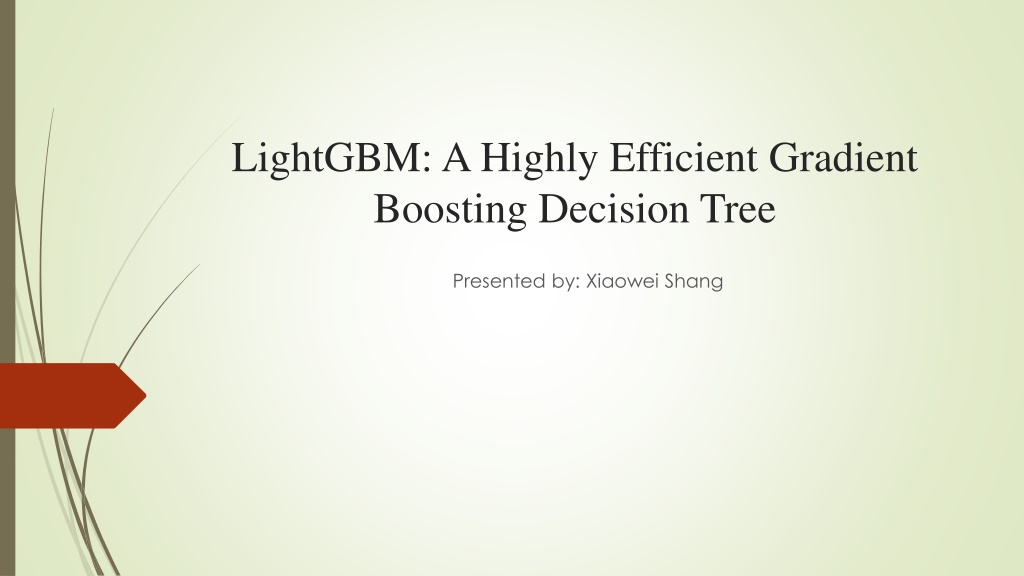Efficient Gradient Boosting with LightGBM
Gradient Boosting Decision Tree (GBDT) is a powerful machine learning algorithm known for its efficiency and accuracy. However, handling big data poses challenges due to time-consuming computations. LightGBM introduces optimizations like Gradient-based One-Side Sampling (GOSS) and Exclusive Feature Bundling (EFB) to improve efficiency and scalability in GBDT implementations. By reducing data instances and feature dimensions, LightGBM enhances training speed and performance.
Download Presentation

Please find below an Image/Link to download the presentation.
The content on the website is provided AS IS for your information and personal use only. It may not be sold, licensed, or shared on other websites without obtaining consent from the author. Download presentation by click this link. If you encounter any issues during the download, it is possible that the publisher has removed the file from their server.
E N D
Presentation Transcript
LightGBM: A Highly Efficient Gradient Boosting Decision Tree Presented by: Xiaowei Shang
Background Gradient boosting decision tree (GBDT) is a widely-used machine learning algorithm, due to its efficiency, accuracy, and interpretability. GBDT achieves state-of-the-art performances in many machine learning tasks, such as multi-class classification, click prediction, and learning to rank. In recent years, with the emergence of big data, GBDT is facing new challenges, especially in the tradeoff between accuracy and efficiency. Conventional implementations of GBDT need to, for every feature, scan all the data instances to estimate the information gain of all the possible split points. Therefore, their computational complexities will be proportional to both the number of features and the number of instances. This makes these implementations very time consuming when handling big data.
The decision tree model splits each node at the most informative feature (with the largest information gain). For GBDT, the information gain is usually measured by the variance after splitting, which is defined as below.
a straightforward idea is to reduce the number of data instances and the number of features. While there are some works that sample data according to their weights to speed up the training process of boosting , they cannot be directly applied to GBDT
Problem Although many engineering optimizations have been adopted in these implementations, the efficiency and scalability are still unsatisfactory when the feature dimension is high and data size is large. A major reason is that for each feature, they need to scan all the data instances to estimate the information gain of all possible split points, which is very time consuming.
Solution Since the histogram-based algorithm is more efficient in both memory consumption and training speed, we will develop our work on its basis. To reduce instance number, GOSS is proposed. To reduce feature number, EFB is proposed.
Gradient-based One-Side Sampling (GOSS) . we should better keep those instances with large gradients ,and only randomly drop those instances with small gradients. Specifically, GOSS firstly sorts the data instances according to the absolute value of their gradients. second, it keeps the top-a 100% instances with the larger gradients and get an instance subset A; then, for the remaining set Ac consisting (1 a) 100% instances with smaller gradients, further randomly sample a subset B with size b |Ac |; finally, we split the instances according to the estimated variance gain V j (d) over the subset A B, i.e.,
Exclusive Feature Bundling (EFB). With EFB, we bundle mutually exclusive features (i.e., they rarely take nonzero values simultaneously), to reduce the number of features. we design an efficient algorithm by reducing the optimal bundling problem to a graph coloring problem and solving it by a greedy algorithm with a constant approximation ratio. There are two issues to be addressed. The first one is to determine which features should be bundled together. The second is how to construct the bundle.
Evaluation Our experiments on multiple public datasets show that, LightGBM speeds up the training process of conventional GBDT by up to over 20 times while achieving almost the same accuracy. XGBoost outperforms the other tools. So, we use XGBoost as our baseline in the experiment. experimental environment is a Linux server with two E5-2670 v3 CPUs (in total 24 cores) and 256GB memories. All experiments run with multi- threading and the number of threads is fixed to 16.
Future work For the future work, we will study the optimal selection of a and b in Gradient-based One-Side Sampling and continue improving the performance of Exclusive Feature Bundling to deal with large number of features no matter they are sparse or not.




























